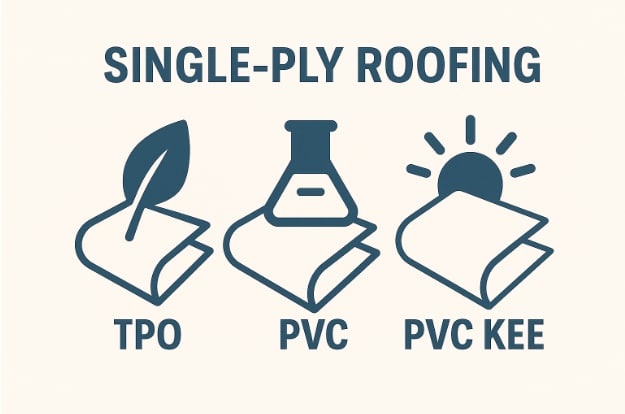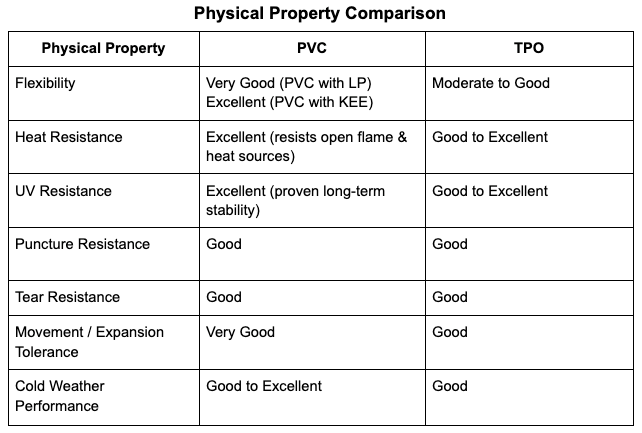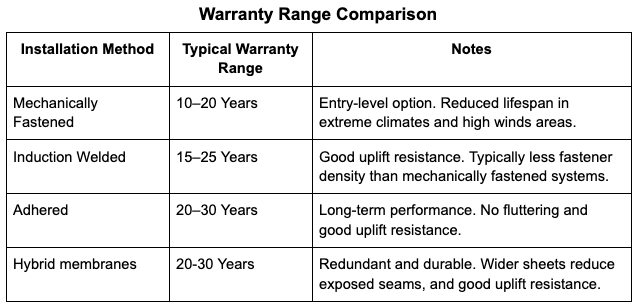If you are just getting started in the roofing industry, chances are you have already come across the term single-ply roofing. It is a popular roof system used on commercial and industrial buildings, especially low-slope rooftops, and offers a solid balance of durability, ease of installation, and energy efficiency.
Two of the most common single-ply membrane types are PVC and TPO. At a glance, they can look the same—but the chemistry behind each plays a big role in how they perform. This quick guide breaks down the basics so you can start making informed decisions.

What Is Single-Ply Roofing?
Single-ply systems use a single layer of flexible membrane—typically white—to weatherproof and protect a building. These membranes are mechanically fastened, adhered with adhesives, or induction welded to the substrate. Sometimes a combination of attachment methods are used to secure a roofing system.
Both TPO and PVC membranes are designed to resist UV rays, reduce rooftop temperatures, and stand up to the elements. But the materials themselves are quite different.
Breaking Down the Material Basics
PVC (Polyvinyl Chloride)
PVC is a thermoplastic membrane made primarily from vinyl. It's been used in roofing for decades. One key characteristic that sets PVC apart is its chemical resistance—it holds up well against grease, oils, and some industrial pollutants. Some versions are enhanced with KEE (Ketone Ethylene Ester) for added flexibility and durability. For additional information about PVC, PVC KEE, and KEE membranes, refer to this article and this article.
TPO (Thermoplastic Polyolefin)
TPO is a blend of rubber and plastic (typically ethylene-propylene and polypropylene-based). TPO does not require added plasticizers to stay flexible, which gives TPO an advantage when it comes to long-term movement and expansion/contraction cycling. TPO is also known for being more environmentally friendly (TPO does not include any Redlist materials) and recyclable.
Chemical Resistance or TPO, PVC, and PVC KEE
The following chart provides guidelines on the chemical resistance of thermoplastic single-ply membranes.

A=Negligible Effect: The membrane should be suitable for all applications where these materials could be present.
B=Limited Absorption of Effect: The membrane should be suitable for most applications. However, staining may occur and/or there may be reduced resistance to heat and UV
exposure.
C=Extensive Absorption and/or Rapid Degradation Possible: Membrane may be suitable for applications where only intermittent contact is involved and contact with the membrane is for short periods of time.
NR=Not Recommended: The membrane may dissolve or disintegrate, and weather resistance may be severely reduced.
Key Takeaway: If the roof is over a kitchen, a restaurant, or an industrial facility, PVC is the preferred option. And it's important to recognize that PVC membranes blended with KEE generally perform better than standard PVC membranes in chemical exposure testing.

Key Takeaway: It is important to understand how membrane chemistry equates to performance. Reach out to a Siplast Material Design Specialist for more information.
Installation and Design Notes
Installation methods for both systems are similar—mechanically attached, adhered, or induction welded. For both membrane types, the keys to long-term performance include proper design and proper preparation; experienced installers and quality installation, including compatible components; quality materials (like Siplast's Parasolo PVC and Parasolo TPX); and regular maintenance of the roofing system.
In addition to many other considerations, it is important to account for:
Proper slope and drainage (using tapered insulation when needed)
Chemical compatibility and long-term adhesion with adhesives and substrates
Local code requirements for fire resistance, wind uplift resistance, impact resistance, and energy efficiency
Maintenance & Lifespan
Basic maintenance is critically important for extending service life. Keeping the roof surface free of debris, maintaining proper drainage, and inspecting the system regularly—twice a year in the spring and the fall, and after storms or heavy foot traffic—helps ensure seams, flashings, and penetrations remain watertight.
With proper care, PVC and TPO roofing systems can last 20 to 30 years, depending on the installation method, membrane thickness, manufacturer specifications, and quality of the membrane chemistry. Membranes that are thicker, adhered, and installed with high-quality details typically perform longer and qualify for extended warranties.

Note: Final warranty terms are determined by the manufacturer based on system components, membrane thickness, attachment, and detailing quality.
Final Thoughts
PVC and TPO are both solid choices for commercial roofs. The correct option comes down to the building's specific needs: Occupancy Type – what's happening inside; Geography – where it's located, and Function – how the roof will need to perform.
For example, roof tops on buildings exposed to chemicals or grease might lean toward PVC or PVC KEE, such as Siplast's Parasolo PVC or Siplast's Parasolo KEE. Rooftops exposed to a wide temperature swing might lean towards the heat aging capabilities of a high performing TPO, such as Siplast's Parasolo TPX.
Regardless of the specific material choice, working with a knowledgeable team—and understanding the strengths of each membrane—can make all the difference. For more information, please contact Siplast directly or Find a Rep in your area.


